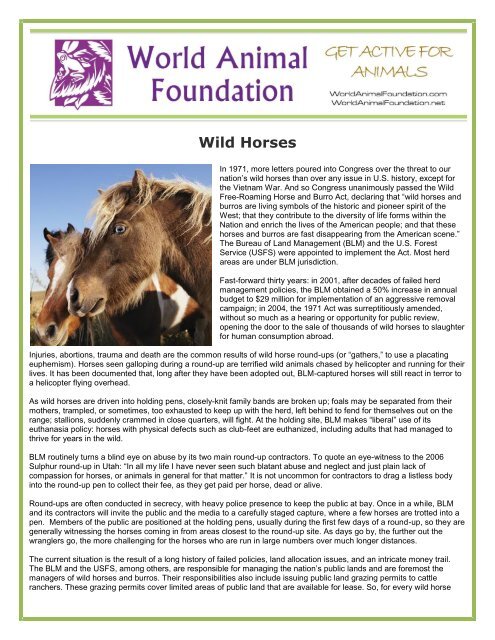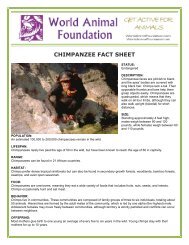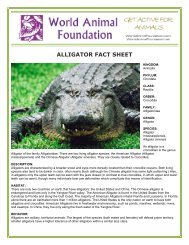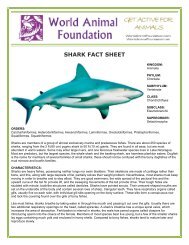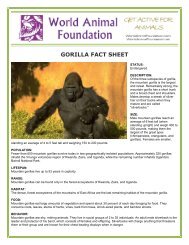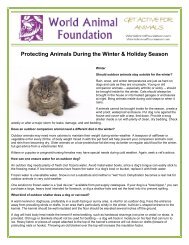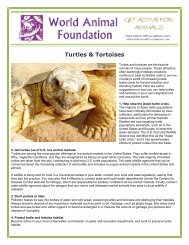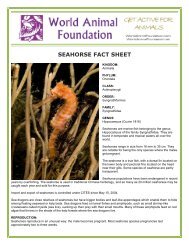Wild Horses - World Animal Foundation
Wild Horses - World Animal Foundation
Wild Horses - World Animal Foundation
- No tags were found...
Create successful ePaper yourself
Turn your PDF publications into a flip-book with our unique Google optimized e-Paper software.
<strong>Wild</strong> <strong>Horses</strong>In 1971, more letters poured into Congress over the threat to ournation’s wild horses than over any issue in U.S. history, except forthe Vietnam War. And so Congress unanimously passed the <strong>Wild</strong>Free-Roaming Horse and Burro Act, declaring that “wild horses andburros are living symbols of the historic and pioneer spirit of theWest; that they contribute to the diversity of life forms within theNation and enrich the lives of the American people; and that thesehorses and burros are fast disappearing from the American scene.”The Bureau of Land Management (BLM) and the U.S. ForestService (USFS) were appointed to implement the Act. Most herdareas are under BLM jurisdiction.Fast-forward thirty years: in 2001, after decades of failed herdmanagement policies, the BLM obtained a 50% increase in annualbudget to $29 million for implementation of an aggressive removalcampaign; in 2004, the 1971 Act was surreptitiously amended,without so much as a hearing or opportunity for public review,opening the door to the sale of thousands of wild horses to slaughterfor human consumption abroad.Injuries, abortions, trauma and death are the common results of wild horse round-ups (or “gathers,” to use a placatingeuphemism). <strong>Horses</strong> seen galloping during a round-up are terrified wild animals chased by helicopter and running for theirlives. It has been documented that, long after they have been adopted out, BLM-captured horses will still react in terror toa helicopter flying overhead.As wild horses are driven into holding pens, closely-knit family bands are broken up; foals may be separated from theirmothers, trampled, or sometimes, too exhausted to keep up with the herd, left behind to fend for themselves out on therange; stallions, suddenly crammed in close quarters, will fight. At the holding site, BLM makes “liberal” use of itseuthanasia policy: horses with physical defects such as club-feet are euthanized, including adults that had managed tothrive for years in the wild.BLM routinely turns a blind eye on abuse by its two main round-up contractors. To quote an eye-witness to the 2006Sulphur round-up in Utah: “In all my life I have never seen such blatant abuse and neglect and just plain lack ofcompassion for horses, or animals in general for that matter.” It is not uncommon for contractors to drag a listless bodyinto the round-up pen to collect their fee, as they get paid per horse, dead or alive.Round-ups are often conducted in secrecy, with heavy police presence to keep the public at bay. Once in a while, BLMand its contractors will invite the public and the media to a carefully staged capture, where a few horses are trotted into apen. Members of the public are positioned at the holding pens, usually during the first few days of a round-up, so they aregenerally witnessing the horses coming in from areas closest to the round-up site. As days go by, the further out thewranglers go, the more challenging for the horses who are run in large numbers over much longer distances.The current situation is the result of a long history of failed policies, land allocation issues, and an intricate money trail.The BLM and the USFS, among others, are responsible for managing the nation’s public lands and are foremost themanagers of wild horses and burros. Their responsibilities also include issuing public land grazing permits to cattleranchers. These grazing permits cover limited areas of public land that are available for lease. So, for every wild horse
emoved from a grazing permit allotment, a fee-paying cow gets to take its place, and a public land rancher gets thebenefit of public land forage at bargain rates. This is the number one reason wild horses are removed from public lands.The 1971 <strong>Wild</strong> Free-Roaming Horse and Burro Act mandated that wild horses be managed at their then-currentpopulation level, officially estimated by the BLM at 17,000 (three years later, BLM’s first census found over 42,000horses). To the horses' detriment, both sides agreed to allow the government to manage wild horse populations at that“official” 1971 level. Eleven years later, a study by the National Academy of Sciences found BLM’s 1971 estimate to havebeen “undoubtedly low to an unknown, but perhaps substantial, degree,” given subsequent census results and taking intoaccount the horses' growth rate and the number of horses since removed. But the damage had already been done;management levels had been etched in stone, and processes for removal of "excess" horses were well in place.The fact is that the 1982 National Academy of Sciences report and two General Accounting Office reports have counteredkey points in BLM's premise for its current herd reduction campaign. These government-sanctioned documents concludedthat: (i) horses reproduce at a much slower rate than BLM asserts, (ii) wild horse forage use remains a small fraction ofcattle forage use on public ranges, (iii) “despite congressional direction, BLM did not base its removal of wild horses fromfederal rangeland on how many horses ranges could support,” and (iv) “BLM was making its removal decisions on thebasis of an interest in reaching perceived historic population levels, or the recommendations of advisor groups largelycomposed of livestock permittees.”From over 2 million in the 1800s, America’s wild horse population has dwindled to fewer than 33,000. There are now morewild horses in government holding pens than remain in the wild, with many of the remaining herds managed at populationlevels that do not guarantee their long-term survival. Still, the round-ups continue.Over the past forty years, federal law enacted by the people on behalf of their wild horses has been ignored. No strategicplan to keep viable herds of wild horses on public lands was ever developed.What You Can Do:Join the American <strong>Wild</strong> Horse Preservation Campaign at www.wildhorsepreservation.org.


